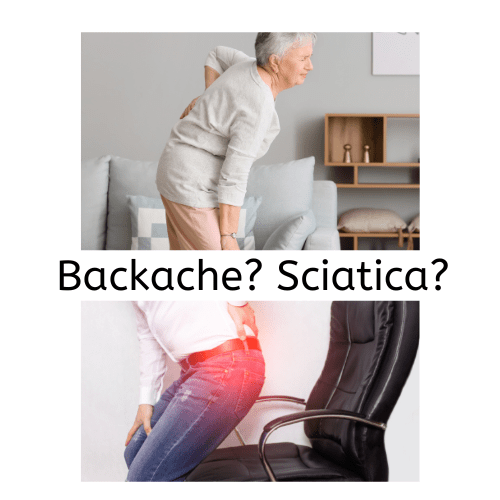
Image Source: Canva Pro
Table of Contents
Backache or Sciatica- which one do you have?
Are you suffering from backache? Does it hurt every time you stand up after sitting for a long time or bend down? Do you have trouble walking because of the shooting pains in your hips and legs? Or are you suffering with sciatica or some other form of back pain? If so, there is no need to worry.
In my daily clinical practice, at least one patient who has some or the other form of backache. Some are simple lumbagos, pains that can are of short nature and that can easily be reduced by simple medications like anti-inflammatory pain killers and muscle relaxants. But some cases of backache are stubborn and need further evaluation in the form of a detailed history and further investigations.
This article will tell you everything you need to know about dealing with back pain and sciatica, including the possible causes, symptoms, and most importantly how you can relieve the pain and get on with your life again.
Would you like to listen this article? Then click the link given below-
Backache and Sciatica or click the audio button below-
What Is Back Pain?
Back pain is any discomfort or pain felt in the back. It is a common condition and can be caused by many different factors. Low back pain is the most common reason people visit their doctor. It can be acute (short-term) or chronic (long-term). The causes of back pain can be broadly classified into mechanical and medical causes.
Mechanical causes include:
- lifting something that is too heavy,
- sleeping in an uncomfortable position,
- sitting for long periods without taking enough breaks, or
- overdoing any type of physical activity.
Overuse injuries and muscle sprains are examples of mechanical causes of back pain.
Medical causes may be due to a problem in the spine, such as:
- a herniated disc,
- spinal stenosis,
- spondylolisthesis,
- scoliosis [a defect in the vertebral column], or
- a fracture.
A herniated disc, or slipped disc, is a common cause of back pain and sciatica.
Sciatica: The Real Deal
Let us first have a look at the anatomical structures that are responsible for both backache and sciatica-
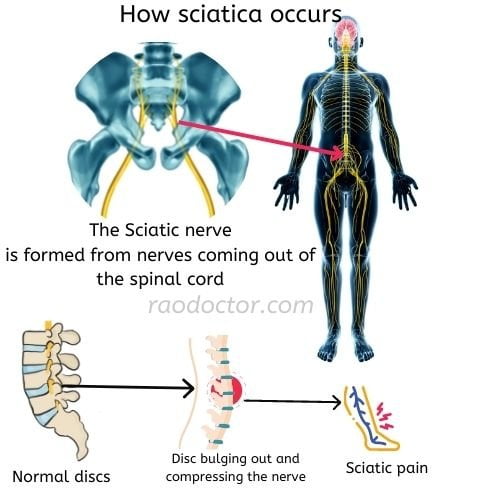
The pain that patients perceive, usually in the back, buttocks or legs, down the lower limb [as shown in the pic above] is called sciatica. This is often a result of pressure from a degenerative disc which compresses the nerve running from the lower spine, and can affect one or both legs.
The most common cause is a lumbar disc herniation and this is what most patients think of when they hear the word “sciatica”. Sciatica is often a symptom of a much more serious health issue, including degenerative disc disease, spinal stenosis, spondylolisthesis, scoliosis, or a fracture.
Possible Causes of Back Pain and Sciatica
There are many probable causes of back pain and sciatica. Here are the most common:
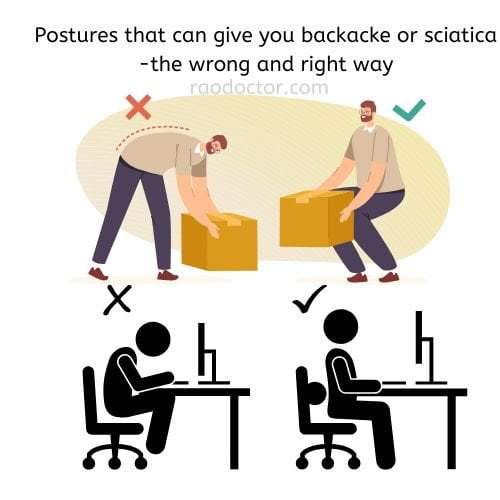
- Lifting heavy objects – incorrect lifting technique [shown above] can strain your back muscles and cause back pain.
- Poor posture – sitting [shown above] or standing with bad posture can put a strain on your back and cause muscle spasms or pain.
- Overexertion – doing too much, too soon can result in strains or sprains.
- Poor sleeping position- Sleeping on your side puts pressure on your lower back; sleeping on your back can flatten the normal curve in your spine.
- Repetitive strain injuries – sitting at a computer for prolonged periods of time can cause muscle spasms and pain.
- Joint dysfunction – osteoarthritis, scoliosis and other structural issues can cause low back pain.
- Structural abnormalities – scoliosis, spondylolisthesis and spinal fractures can cause back pain.
- Slip disc – herniated disc causing sciatica.
- Structural abnormalities – scoliosis, spondylolisthesis and spinal fractures can cause back pain.
- Disc degeneration – with age the discs lose their elasticity and can cause pain.
What is a herniated disc?
A disc is a spongy tissue that sits between the vertebrae [have a look below] at the back of the spine. The discs act as shock absorbers and allow the spine to be flexible. This is how the vertebrae, and the disc are arranged in your vertebral column-

In some people, a disc may become bulged or herniated [pushed forward/slip]. This means a part of the disc has been pushed out through the surrounding tissue and may press on a nearby nerve. This is how a bulged disc looks like –


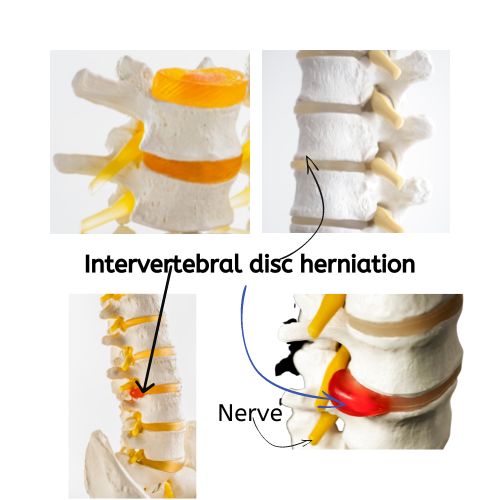
A disc herniation can cause sciatica by the disc pushing the nerve [as shown in picture no.3] causing pain that travels from the lower back down the back of one leg or both legs, depending on which side the disc has slipped.
A disc herniation might be caused by lifting something too heavy, a sudden movement, or poor posture. It can also occur with age and wear and tear of the spine. The discs lose water and become dehydrated, which makes them more brittle and less able to absorb pressure and shock.
Symptoms of Back Pain and Sciatica
Back pain can be mild and come and go, or it can be severe enough to disrupt your daily activities. It may also be accompanied by numbness or tingling in the leg.
If you’re experiencing back pain, the following symptoms could be present:
- Pain and stiffness in the lower back – the pain may radiate into the buttocks, hips, and legs.
- Pain or numbness that travels through the legs – pain may be felt in the calves or feet and may travel down along the back of the leg.
- Loss of strength and mobility in the legs.
- Weird sensation in the legs- this is known as a “pins and needles” sensation in the leg. There is a tingling sensation in the foot sole.
- Difficulty bending or straightening the knee and an inability to walk normal gait.
- Weakness in the leg – decreased sensation in the foot presenting as foot drop
- Clumsiness in the leg – reduced ability to stand on one leg (single leg stance) and inability to balance (ataxia).
How to know you have a Slip disc?
To know this clinically, your doctor may perform a simple test called SLR- the straight leg raise test, as shown below-
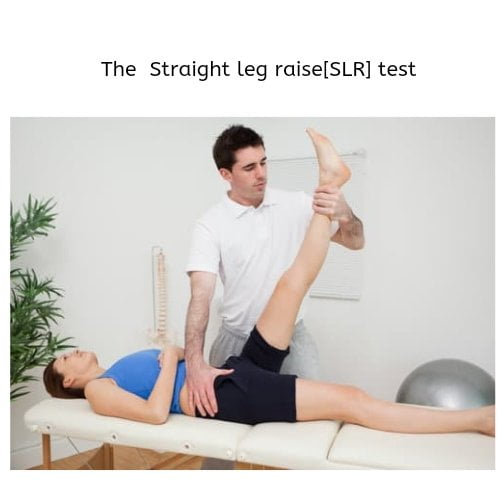
If this test turns out to be positive, that is, if the leg cannot be raised above 45°, then you may be having sciatica. To rule it out or confirm it, your doctor may order the following investigations-
Investigations to rule out Sciatica- X-ray, CT scan or MRI
A diagnostic work-up will be done to rule out any underlying disease as the cause of sciatica. This may include blood tests to rule out any systemic diseases [like tuberculosis, Osteoporosis, etc.], vitamin B12 deficiency, vitamin D3 deficiency, etc.
Imaging studies like X-rays, CT scan or MRI to rule out a herniated disc.
With the usual low back pain, plain X-rays may be negative, but the patient may have positive pain. On the other hand, in sciatica, plain X-rays may be positive as there is a disc bulge/herniation.
To confirm the diagnosis of sciatica, a CT or MRI scan may be done to visualize the herniated disc. If a disc herniation is suspected, an MRI scan is the gold standard imaging test to identify the problem.
Treating Your Back Pain
If the pain is due to a minor injury, it may go away within a few days or weeks. However, you can help reduce the pain and speed up your recovery by following these steps: –
- Rest – Avoid any activity that causes or increases your pain. This may include changing positions, lifting or walking.
- Apply heat – Wrapping a towel in hot water and wrapping it around the affected area can help reduce pain and swelling. You can also use a heating pad as shown here-
 Click here to get it. Image Source- Amazon.com
Click here to get it. Image Source- Amazon.com - Avoid cold temperatures – Avoid cold temperatures, which can constrict blood vessels and delay healing. Ice can be helpful for acute injuries but should be used for no more than 48 hours.
- Exercise – Regular exercise can help reduce pain and improve mobility. It is important that you work with a health professional, like a physiotherapist, to develop an exercise plan that is right for your condition.
- Medications – Over-the-counter pain medications, like ibuprofen, can help reduce pain and inflammation. Other medications, like anti-inflammatory drugs and muscle relaxants, can be prescribed by your doctor if needed. I usually prescribe a muscle relaxant with anti-inflammatory medications and a drug to reduce nerve pain, such as Neorelax MR, Zymogesic, Benalgis Forte. [ if your doctor has prescribed any such medicines, you can use these sites to get them online- 1mg, Netmeds, Pharmeasy]
- Massage – Massaging the painful muscles can help relax and reduce the pain.
Physiotherapy for backache and Sciatica
Physiotherapy, also known as physical therapy, is a common treatment for back pain, sciatica and other musculoskeletal disorders. The goal of physiotherapy is to reduce pain and increase mobility and function. There are many different techniques and exercises that can be used to do this, including:
– Manual therapy – This can include soft tissue mobilization or massage, joint manipulation, or mobilization of a joint, to help with any joint stiffness or restriction.
– Exercise – This can include a range of different exercises, depending on the individual’s condition, including stretching, strengthening, or aerobic exercises. Useful resource-(3 Exercises for Backache) (Piriformis Stretch)
– Modalities – These include heat or cold therapy, hydrotherapy, or electrical stimulation.
– Education and lifestyle modification – This can include advice about posture, managing fatigue, and healthy diet and lifestyle.
I usually recommend 5 to 10 sittings of lumbar traction with short wave diathermy [ to watch in English, click here] to my patients of both backache and sciatica [watch the video below]
Surgical treatment of slip disc
If back pain persists despite appropriate treatment and conservative management, surgery may be necessary. Surgery may be considered if there is a herniated disc that is compressing the nerve and causing sciatica. Surgery may be considered if conservative treatment fails to eliminate or reduce the pain. The most common procedure for a slipped disc is removal of the disc. Nowadays, the disc can be removed through a pinhole operation called Minimally invasive Microdiscectomy.
For more on Spinal Surgery, click here.
Conclusion
When one considers the subject of back pain, it is important to realize that you can experience pain for many reasons. When lumbago is involved, it is typically an inflammation of one or more of the lower back muscles, often caused by overstretching of those muscles. It can also be caused by a herniated disc or other spinal condition.
Other causes of back pain include mechanical disorders such as fractures of the vertebral bones, ligament sprains, musculoskeletal disorders of the spine, or osteoporosis.
When joint or back pain is the primary problem, it is important to receive a thorough evaluation from a healthcare provider. That way, the underlying cause of your chronic pain can be determined and treated with the most effective care available.
My next article will be about another common cause of pain- Cramps. Please share this article as well as sign up for my newsletter [ if you not already done so] by providing your email id and be the first one to receive updated news on the articles I have published.
You can use the share icons at the bottom of this article or just CLICK the link below to share on Twitter-
Do You Have Backache or Sciatica? Learn how To Relieve Your Pain Share on XAdios.
Disclosure-
This article uses links that when clicked and a purchase made using the link can benefit the author by him receiving a small commission without any extra cost to the user of the link.


